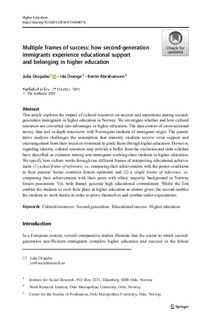Multiple Frames of Success: How Second- Generation Immigrants Experience Educational Support and Belonging in Higher Education
Peer reviewed, Journal article
Published version
Permanent lenke
http://hdl.handle.net/11250/2631786Utgivelsesdato
2019Metadata
Vis full innførselSamlinger
- Publikasjoner fra CRIStin [716]
- Tidsskriftpublikasjon [389]
Sammendrag
This article explores the impact of cultural resources on success and aspirations among second-generation immigrants in higher education in Norway. We investigate whether and how cultural resources are converted into advantages in higher education. The data consist of cross-sectional survey data and in-depth interviews with Norwegian students of immigrant origin. The quantitative analysis challenges the assumption that minority students receive extra support and encouragement from their social environment to guide them through higher education. However, regarding identity, cultural resources may provide a buffer from the exclusion and risks scholars have described as common among non-immigrant working-class students in higher education. We specify how culture works through two different frames of interpreting educational achievement: (1) a dual frame of reference, i.e. comparing their achievements with the poorer conditions in their parents’ home countries fosters optimism and (2) a single frame of reference, i.e. comparing their achievements with their peers with ethnic majority background in Norway fosters pessimism. Yet, both frames generate high educational commitment. Whilst the first enables the students to view their place in higher education as almost given, the second enables the students to work harder in order to prove themselves and combat under-expectations.
